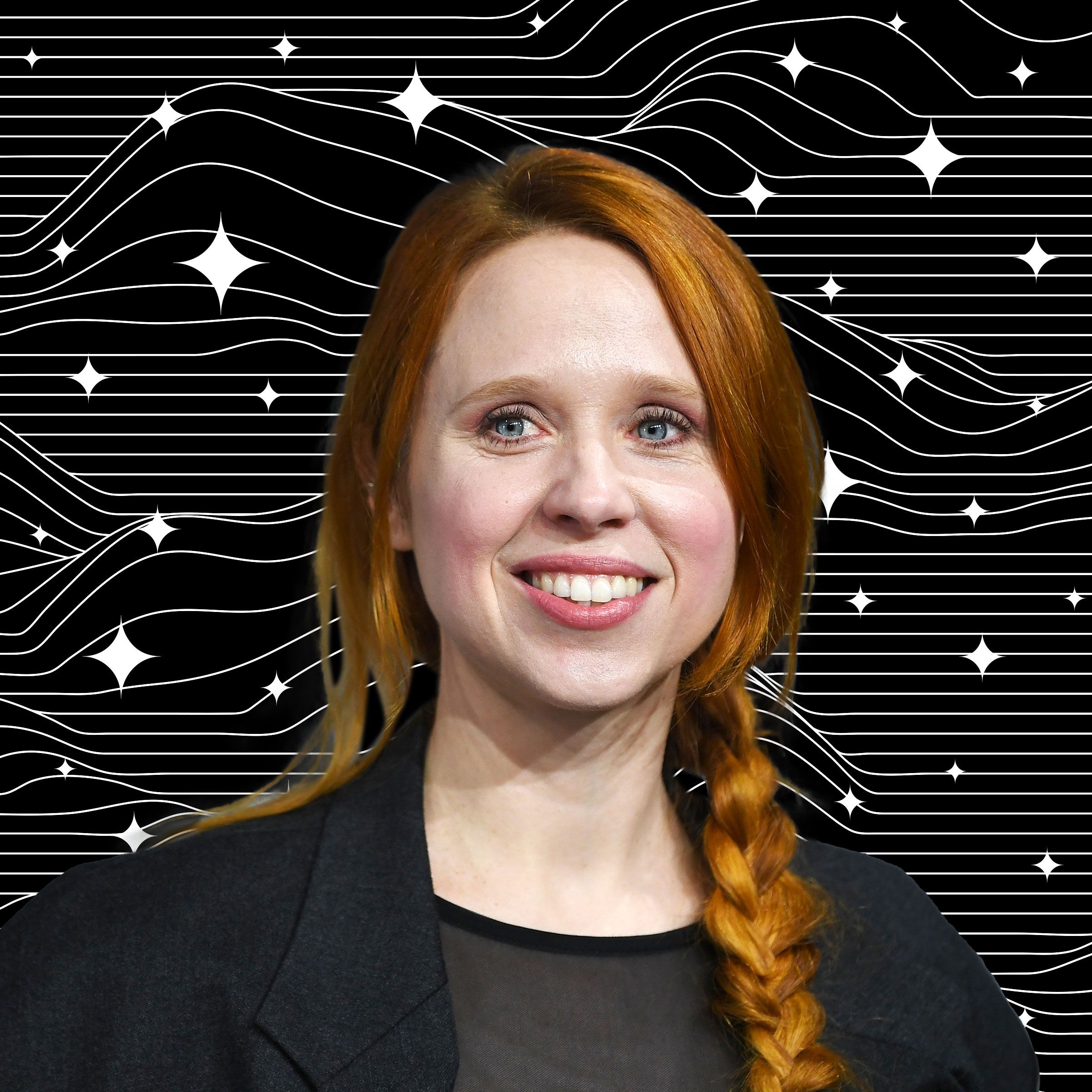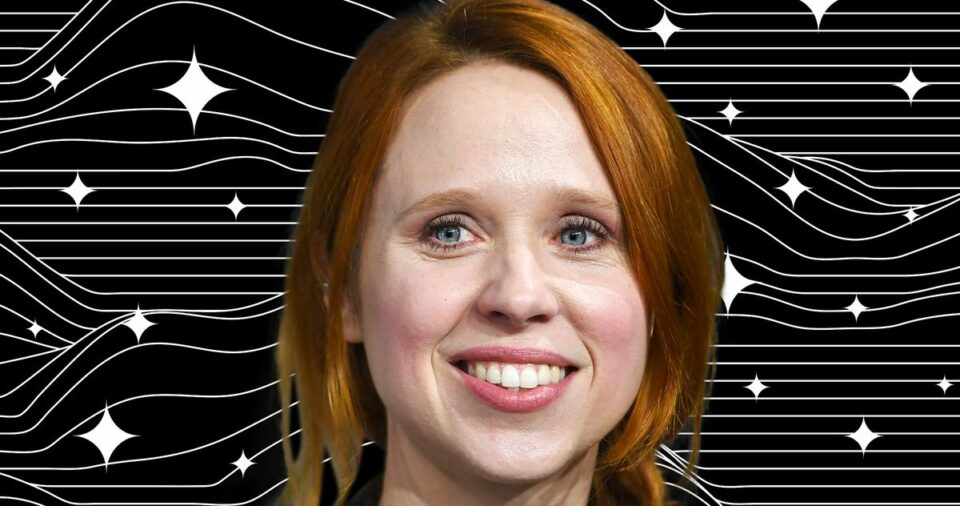
If you scan through nearly any news article about the unknown future of music under the expansion of artificial intelligence, it won’t take you long to locate the name Holly Herndon. The 42-year-old composer, technologist, and experimental electronic musician is one of the intrepid digital pioneers steering the public through a new world order in which anyone can generate a fresh Drake song with just a click. Some musicians are panicking about going obsolete thanks to artificially generated duplicates; meanwhile, in 2021 Herndon launched her own “deepfake twin,” Holly+, which others can collaborate with to create compositions in her voice. “There’s a narrative around a lot of this stuff that it’s scary dystopian,” Herndon told Wired. “I’m trying to present another side: This is an opportunity.”
Alongside her husband, the academic Matt Dryhurst, Herndon delves into the wild possibilities and ethical ambiguities of new technology, considering how innovation can co-exist with artists’ rights. In 2019, she made an errant, fantastical album with riffs from an “AI baby” she named “Spawn,” training the program on approximately 50,000 voices singing basic choral melodies. The result, Proto, erupts with violent, juddering beats and elfin cries, as if beamed from a mythical kingdom anticipating war against enemy territory. More recently, Herndon and Dryhurst co-founded a company, Spawning, which encourages consent in AI; their first release is a website called Have I Been Trained?, which enables users to see whether their work has been used by A.I. training models like Stable Diffusion and opt out of future use. She and Dryhurst also demystify the process and ideas behind their projects on their podcast, Interdependence, where they host researchers, policymakers, and artists; its tagline, fittingly, is “Optimistic about the 21st century.”
Now Herndon and Dryhurst are among the 71 artist participants in the 2024 Whitney Biennial. Their project, xhairymutantx, presents a text-to-image AI model trained on strange images of Herndon as a kind of hybrid Rapunzel and Michelin man, with long strands of orange hair and a hulking body. Via the Whitney’s art portal, users can prompt mutant Herndon in a profusion of scenarios: riding a whale in the ocean, floating in a space capsule, preparing coq au vin at the Last Supper. (Some results have no discernible trace of Herndon, like one image of Simone Biles with three legs.) These images will eventually filter into the training data used by other AI models, changing who “Holly Herndon” is in the digital realm. Celebrities traditionally disseminate their image to the public, but Herndon is giving the public control.
Your hair is overflowing in these images. How did you land on your current hairstyle — the blunt chop with long strands?
A close friend of mine was cutting my hair back when we were broke club kids. He was like, “You really should do this Les Rita Mitsouko haircut. It’s amazing.” I looked her up, and she’s this incredible French pop star, like punk, and just an amazing performer character. I fell in love with the haircut, and I was like, That’s it. That’s the one.
How did you want the haircut to make you feel when you got it? What do you think it conveys?
I’m really lazy about doing my hair — even as a kid, I would go to school with my hair wet and that drove my mom crazy. So I wanted something that made me look put together even though I wasn’t really working on it.
It’s such a part of my identity that I don’t know that it communicates anything beyond Holly-ness at this point. That’s something that we’re exploring with the Whitney piece. The hair became like kudzu, growing over and taking over everything. If you prompt my name through DALL-E or Midjourney, the face will change. Sometimes there will be blue eyes or a floating computer. But there’s always hair. It’s really interesting to see how there’s this battleground around concepts.
What were you trying to achieve with the xhairymutantx project?
We were asking ourselves, “How much control do we have over our own identity?” The idea of the internet was that you could be who you wanted to be — that’s the dream of Instagram, right? You can portray this fantasy life of yourself. But in these models, you have no control.
We wanted to see if we could play with that in some way. We developed a costume that’s an insanely large haircut with long braids and also a kind of superhero mutant version of myself. We took a bunch of images of me in that costume, and that informs the model that we’re hosting on the Whitney site. Every couple of months, people update their models, and so they’ll do a fresh crawl of the internet. So it’s a weird collaboration with various tech companies in terms of how that data is going to be ingested and then how it mutates my identity online.
Is it weird to confront all of these different versions of yourself that you didn’t create?
I trained a model on my singing voice and then let people sing through it and make work with it. That was super-jarring — the first time we got it working, I was in the studio with my partner, Matt. He has a British accent, but it was my voice coming out of the speaker. I jumped and ran out of the room because it was freaky. But then we were working with it for so long it helped me prepare for this kind of decentralization of my identity.
Seeing myself through other people’s prompts and performance helps me see that not everyone sees the same thing. It helps me be more playful with how I approach my own identity. As people, we’re constantly changing, and renegotiating relationships with ourselves. I had a baby a year ago, and that was just as complex.
What do you think it means to be an “It” girl? You’re kind of like one in this experiment — the model is studying and copying you, adopting your visual signatures.
An “It” girl is someone who is taking in the changing world around her and translating that through her own identity. In prior decades, this was more focused on art and fashion as the area where radical new ideas were being worked out. Now I would add tech to that. So the “It” girl today understands how technology is changing the world around her and is experimenting with it through the way she presents herself to the world. Martine Syms, Auriea Harvey, and Marianna Simnett are contemporaries who are doing cool work in this area, building on the work of Lynn Hershman Leeson, Laurie Anderson, and Pauline Olivieros, among many others, and from the distant past Hildegard von Bingen.
What do you think an “It” girl might look like in an age where your likeness can so easily be duplicated and manipulated by other people?
Technology has always impacted the story of the girl. You project your own fantasy onto what you think a young hip woman should be doing. Pre-internet, it was through photographs and magazines. And then the internet allows you to step into their highly filtered and edited world. This next phase is stepping into that person’s life virtually. That’s a really ripe area for exploration, allowing people to perform your identity through you.
I think the concept of celebrity is going to mutate in really weird ways. The fact that it’s so easy to create media could further entrench existing power structures. But I also think that young people might try to break it and mutate it in ways I can’t predict and that I’m extremely excited to see.
How will people try to stand out in this era of infinite media? Will everyone need their own signature hairstyle?
Don’t you think that already exists? That’s how the algorithm works now anyways; it’s like people are reduced to like a tag word. If you can have something really eye-popping, one topic or one thing that’s associated with one person, that’s how that person is mimetic and travels.
Last question. What is your media diet?
I listen to probably way too many podcasts, like New Models and Do Not Research. I also watch a lot of really boring YouTube videos where people are presenting papers. I used to spend a lot more time on Twitter, but something about having a kid made it difficult for me to care about niche flame wars on social media.
This interview has been edited and condensed for clarity.
By Cat Zhang , 2024-03-28 15:19:31
Source link


